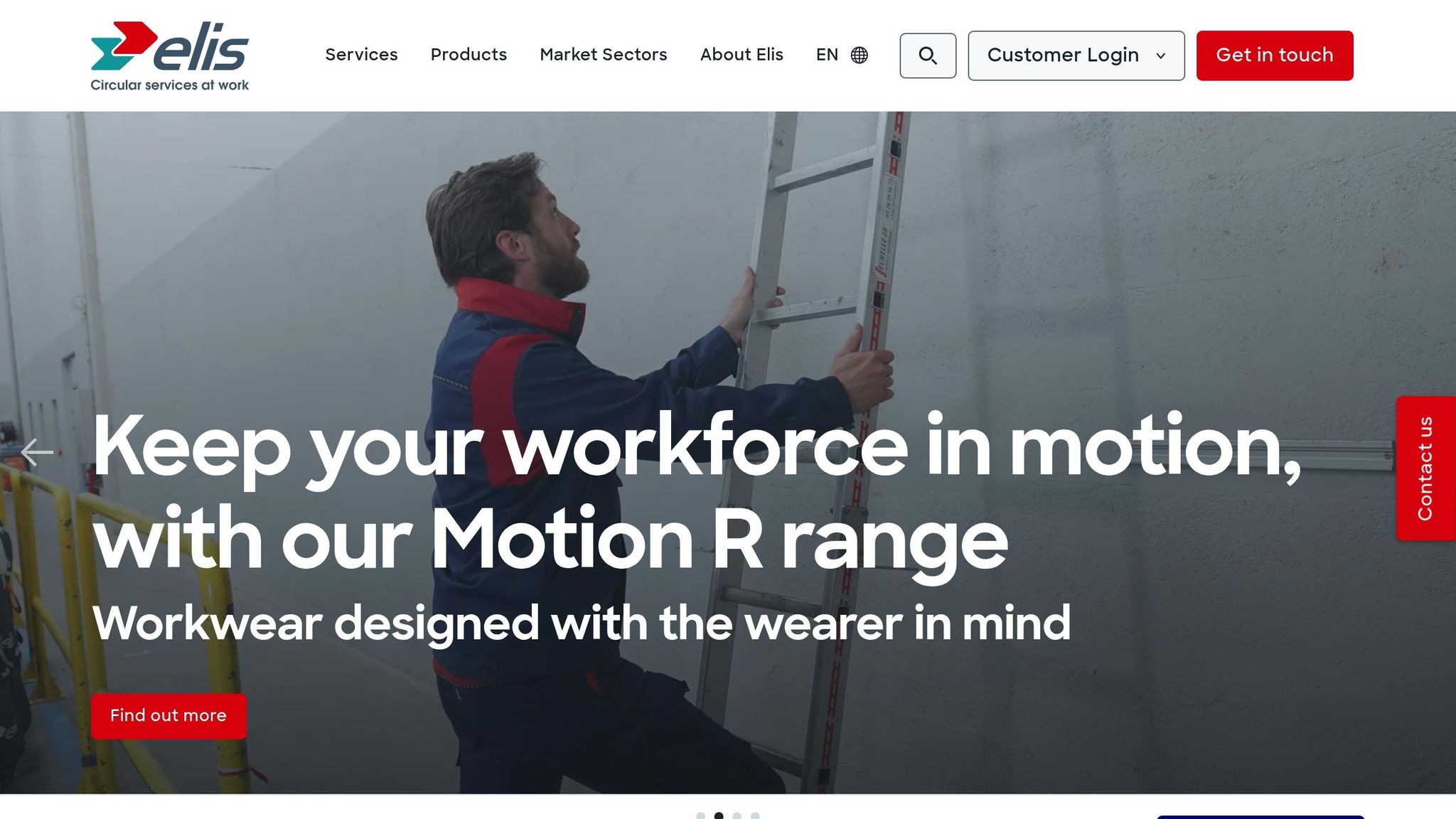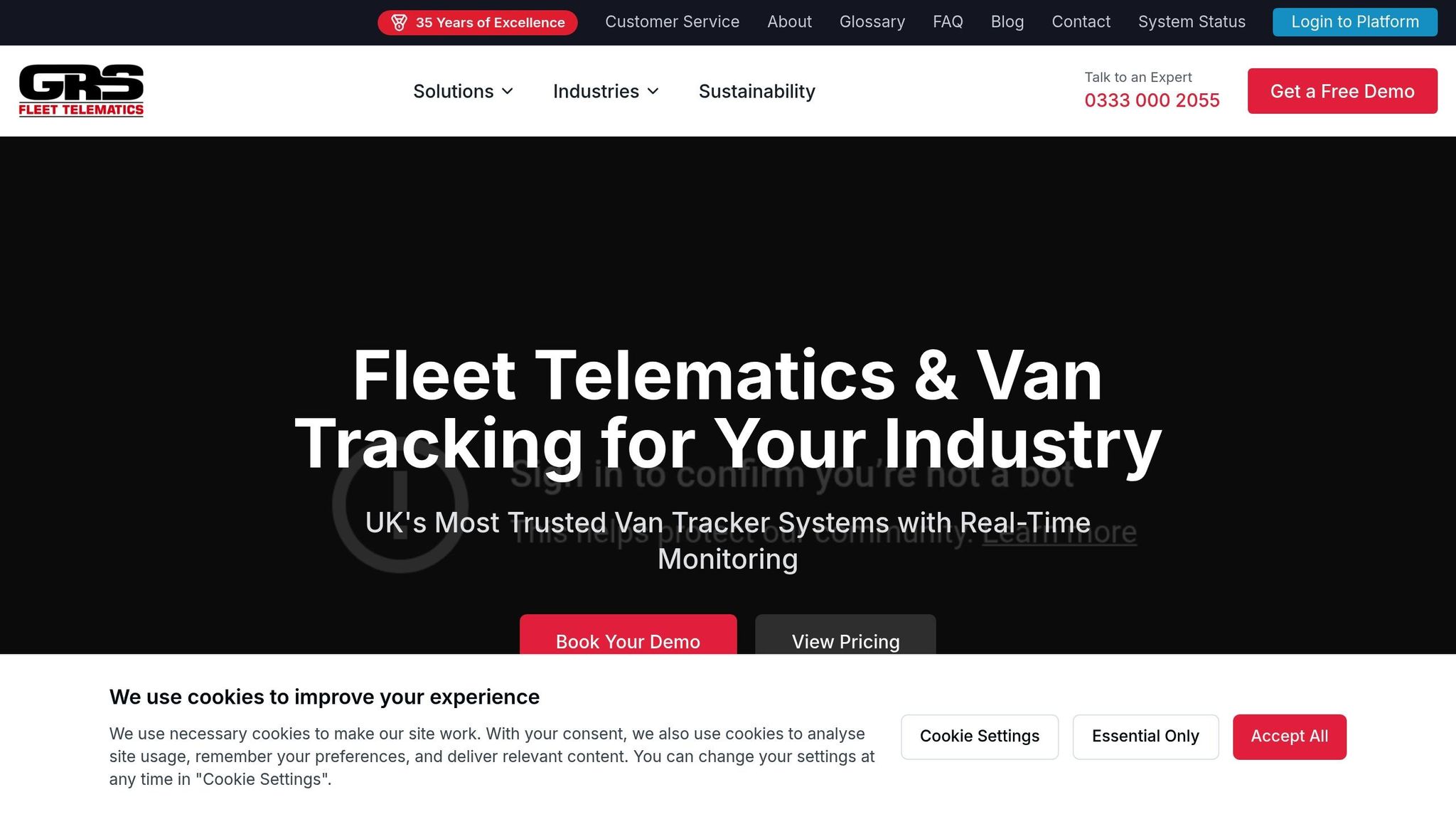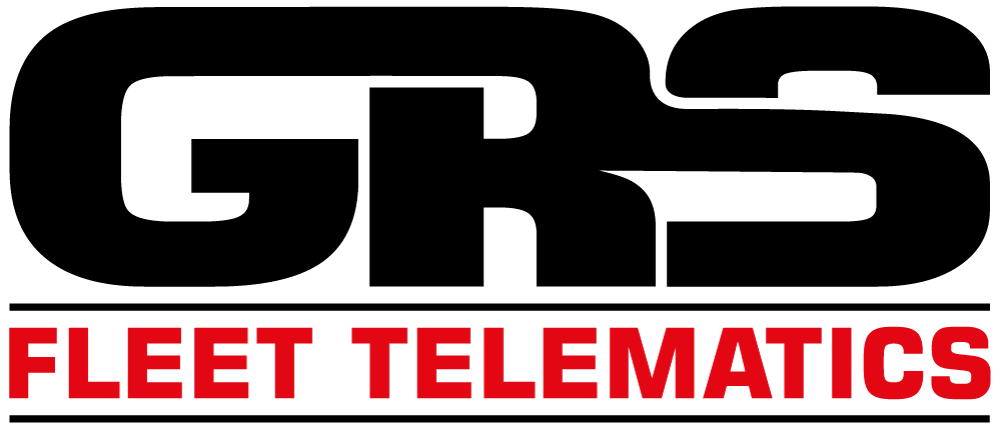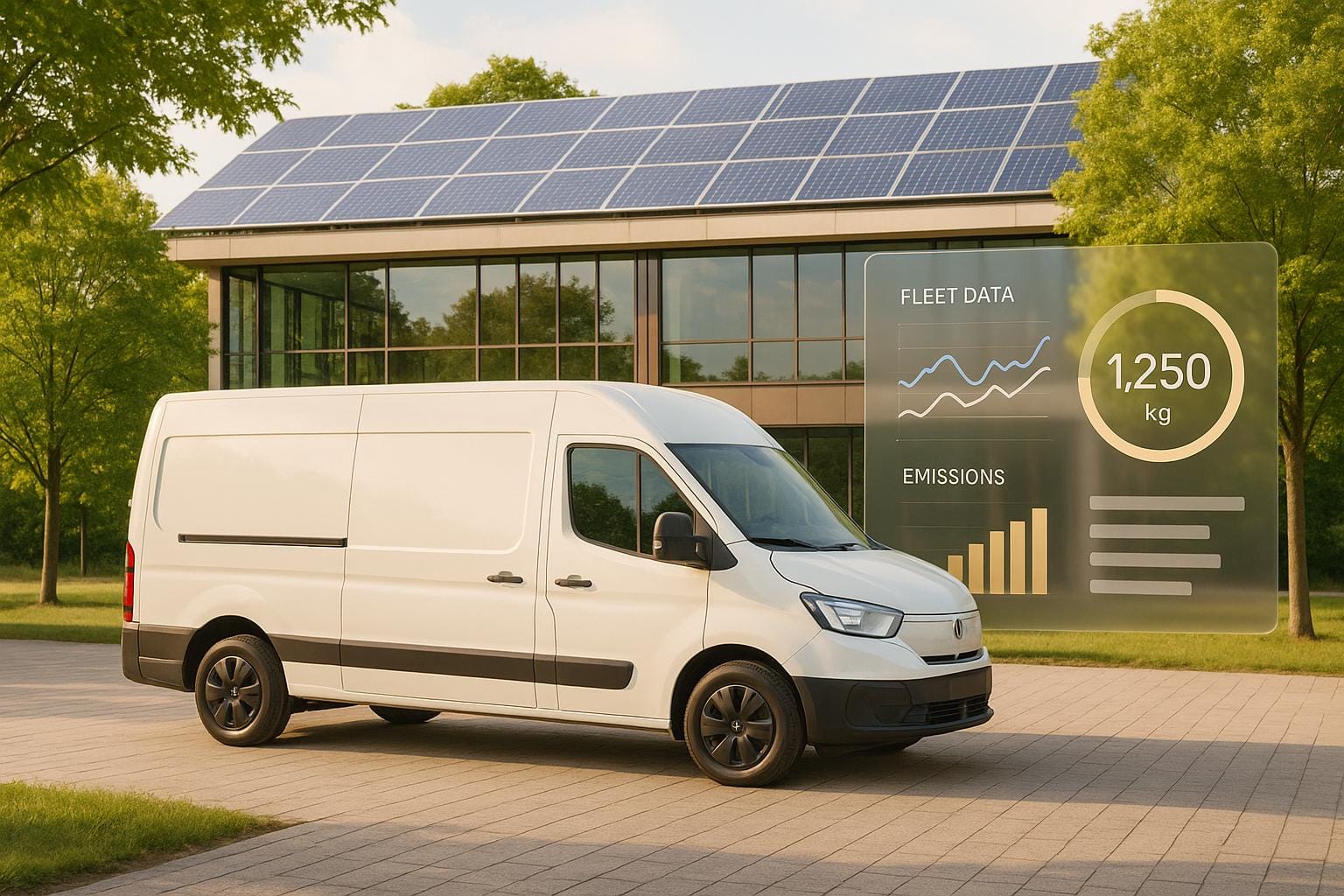Fleet data is essential for accurate carbon reporting, especially in the UK, where only 27% of companies measure fleet CO₂ emissions correctly. With regulations tightening, such as SECR and upcoming SDR requirements, businesses face risks of penalties, reputational harm, and missed opportunities if they fail to adapt. Telematics systems offer precise, automated data collection, replacing outdated methods like spreadsheets, to ensure compliance and improve efficiency.
Key Points:
- Only 21.4% of UK companies use fleet management systems, compared to 43% in Europe.
- SECR and SDR regulations demand detailed emissions reporting, including Scope 1, 2, and 3 emissions.
- Telematics tracks fuel consumption, mileage, idling, and driving behaviour, enabling accurate carbon reporting.
- Real-time and historical data help identify inefficiencies and reduce emissions.
Elis UK customer case study – Delivering a substantial ROI with WEBFLEET and camera integration

UK Carbon Reporting Regulations for Fleets
In the UK, fleet operators are required to meet strict carbon reporting standards, making accurate fleet data a vital component of compliance. These regulations compel businesses to measure, calculate, and disclose greenhouse gas emissions related to their transport activities.
The specific requirements differ depending on the size and structure of the business, so understanding these obligations is essential to avoid potential penalties.
Main Regulatory Requirements and Deadlines
The Streamlined Energy and Carbon Reporting (SECR) framework is the cornerstone of the UK’s carbon reporting regulations. It mandates that publicly quoted companies disclose global energy use and greenhouse gas emissions in their annual Directors' Report. This obligation also extends to large unquoted companies and limited liability partnerships, requiring them to report their annual energy use and emissions.
While SECR initially focused on larger businesses, the framework is set to expand, bringing SMEs and supply chains into its scope. This move underscores the government’s aim to ensure broader accountability for carbon emissions across all industries.
From 1 January 2026, the UK Sustainability Disclosure Requirements (SDR) will come into effect. These rules require companies and financial institutions to report their environmental and social impacts, including detailed climate-related data such as vehicle carbon emissions. Under SDR, businesses must disclose Scope 1, 2, and 3 emissions, as well as UK energy use, which includes transport fuel consumption.
Additionally, the UK Sustainability Reporting Standards (SRS), based on IFRS S1 and S2, will apply to large businesses starting Q3 2025. These standards demand detailed reporting of Scope 1 and 2 emissions, placing stricter requirements on fleet operations.
For certain industries, there are additional deadlines to consider. For instance, under the UK Emissions Trading Scheme (UK ETS), aircraft operators must report their aviation emissions by 31 March of the following year and surrender allowances by 30 April. Meanwhile, UK ETS installations need to submit data between 1 April and 30 June 2025.
Another regulation, the New Heavy Duty Vehicles (Carbon Dioxide Emission Performance Standards) (Miscellaneous Amendments) Regulations 2025, sets specific CO₂ emissions targets for new heavy-duty vehicles, adapting EU regulations to meet UK-specific needs.
Despite these comprehensive measures, 23% of fleet managers remain unaware of the financial penalties tied to non-compliance. As enforcement becomes stricter, this lack of awareness could lead to significant risks.
These regulatory frameworks emphasise the importance of leveraging precise fleet data, which will be discussed further in the context of telematics-based emissions calculations.
Government Greenhouse Gas Conversion Factors
To simplify emissions reporting, the UK Government provides annual greenhouse gas conversion factors. These factors help standardise the process of converting fleet activity data into carbon emission figures. They are specifically designed to align with SECR requirements, ensuring consistent and accurate reporting.
The conversion factors translate data such as fuel usage or distance travelled into carbon emissions, allowing organisations to compare their performance with others. The government offers three versions: a condensed set for general users, a full set for detailed calculations, and a flat file format for automated systems.
These factors are updated annually to reflect changes in fuel composition, grid carbon intensity, and advancements in emissions science. Organisations are encouraged to review the "what's new" section with each update to maintain consistency in their reporting.
Designed to accommodate both UK-based businesses and international organisations reporting on UK operations, these tools provide a standardised approach for emissions calculations across various sectors. Fleet operators are advised to use the condensed set unless advanced calculations are necessary, and to consult the guidance materials included with each release.
Using Telematics Data to Calculate Carbon Emissions
Telematics systems have revolutionised carbon emissions reporting, shifting it from rough estimates to precise, data-driven calculations that comply with government standards. Instead of relying on manual logbooks or estimated fuel usage, these systems gather real-time data, enabling accurate emissions tracking. This ensures that emissions align with regulatory requirements and eliminates guesswork.
By continuously monitoring vehicle performance and driver behaviour, telematics creates a detailed carbon profile for each vehicle, including an eco score. Below, we explore the critical data streams that make these calculations possible.
Key Data Points from Telematics Systems
Modern telematics systems collect a variety of data streams that are essential for calculating carbon emissions with precision. Each data point contributes uniquely to the process:
- Fuel consumption: Telematics systems monitor the actual litres of fuel used, replacing estimates with precise measurements. This accuracy is vital when applying government conversion factors, as even minor errors can significantly affect annual emissions totals.
- Mileage tracking: Exact distances travelled are recorded, which is especially helpful for mixed fleets where fuel data might be incomplete. This eliminates the inaccuracies often found in manual reporting.
- Idling time: Extended idling generates unnecessary emissions. Telematics tracks idling, offering fleet managers opportunities to address this often-overlooked source of carbon output.
- Driving behaviour: Metrics such as harsh braking and speeding are monitored, as these behaviours lead to higher fuel consumption and emissions. This data provides actionable insights for improving driver habits.
- Route efficiency: Information like miles per delivery and fuel consumption per route allows for a deeper analysis of operational carbon intensity, helping optimise delivery planning.
For the most accurate tracking, fleet managers should rely on actual energy consumption data - whether fuel or electricity - using tools like fuel cards, telematics systems, or EV charging station meters. This ensures compliance with government conversion factors and regulatory expectations.
Using Real-Time and Historical Data for Carbon Analysis
Combining real-time and historical data enhances the ability to manage carbon emissions effectively. Real-time monitoring enables immediate corrective actions, while historical data helps identify long-term trends and seasonal variations.
- Baseline comparisons: Monthly and quarterly data can be used to track progress, revealing patterns and trends in emissions over time.
- Driver performance analysis: Weekly or monthly reviews of metrics like idling, harsh braking, and speeding can highlight areas where drivers may benefit from eco-driving training to reduce emissions.
- Route efficiency monitoring: Analysing daily or weekly data uncovers the most carbon-intensive routes, supporting decisions on route optimisation, vehicle allocation, and delivery schedules.
To ensure accurate reporting, fleet managers should clearly define each vehicle's role within the fleet and align their tracking with the appropriate GHG Protocol Scope.
Measurement Approaches for Compliance
The method of measurement depends on compliance requirements. Below is a summary of key approaches:
| Approach | Key Metrics | Timeframe | Benefits |
|---|---|---|---|
| Baseline Comparison | Fuel consumption, CO₂ emissions, mileage | Monthly/Quarterly | Tracks progress over time |
| Driver Performance | Harsh braking, speeding, idle time | Weekly/Monthly | Identifies training opportunities |
| Route Efficiency | Miles per delivery, fuel per route | Daily/Weekly | Improves operational planning |
| Vehicle Performance | Fuel economy, maintenance costs | Monthly/Quarterly | Ensures vehicles operate at peak performance |
To maintain accuracy, it’s crucial to regularly validate and update data, especially when changes occur in vehicle usage, fuel types, or energy sources. Collaborating closely with GHG reporting teams will also help integrate telematics data seamlessly, ensuring full compliance with carbon reporting regulations.
How to Create Carbon Reports Using Fleet Data
Turning fleet data into accurate carbon reports involves a structured process that combines the right telematics setup, the use of official government conversion factors, and strict quality checks. Here’s a step-by-step guide on how fleet operators can transform raw data into compliant carbon emissions reports.
Setting Up Telematics for Data Collection
The first step in carbon reporting is ensuring your telematics system is correctly installed and configured. These devices collect vital data using GPS and sensors, which are essential for calculating emissions.
Installing the Hardware
Most telematics devices are designed for easy installation, often connecting directly to the OBD-II port. Once installed, make sure the device is secured and functioning properly.
For more advanced systems that require integration with the vehicle’s electrical system, professional installation is advisable. This not only ensures reliability but also protects the vehicle’s warranty. If your fleet uses factory-fitted telematics, no additional installation is needed.
Configuring the Software and Training Your Team
After installing the hardware, the next step is setting up the software to track the metrics needed for carbon reporting. This data is securely transmitted to servers and displayed through fleet management platforms.
"Telematics is a method of monitoring cars, trucks, equipment and other assets using GPS technology and on-board diagnostics (OBD) to plot the asset movements on a computerised map." - Geotab Team
It’s crucial that your team understands how to access and interpret key data points such as fuel consumption, mileage, idling time, and driving behaviour. Proper training ensures everyone can contribute to accurate reporting.
Using Government Conversion Factors with Your Data
The UK Government provides annual conversion factors specifically for greenhouse gas reporting. These are essential for organisations complying with Streamlined Energy and Carbon Reporting (SECR) regulations. These factors help convert activity data - like distance travelled or fuel used - into carbon emissions.
Getting the Latest Conversion Factors
You can download the most recent conversion factors from the UK Government’s website. For example, the 2025 factors were released on 10th June 2025 by the Department for Energy Security and Net Zero.
The spreadsheet comes in three formats: a simplified version for general users, a detailed version for advanced needs, and a flat file for automated systems. If you’re new to this, start with the introductory worksheet and guidance. Regular users should check the "what’s new" section for updates.
Applying Conversion Factors to Your Data
To calculate emissions, multiply your telematics data by the relevant conversion factor. For instance, if your system records 1,000 litres of diesel consumption, applying the diesel conversion factor will give you the CO₂ emissions. The spreadsheet organises these factors by GHG Protocol Scopes 1, 2, and 3. Choose the correct factor based on the fuel type and the data your system collects. While fuel consumption data is typically the most accurate, distance-based calculations can serve as a backup if fuel data is incomplete.
Once you’ve applied the conversion factors, the next step is to ensure data quality for compliance.
Checking Data Quality and Meeting Compliance Standards
Converting your data into emissions values is only part of the process. Ensuring the accuracy of your data is key to meeting compliance standards and producing reliable carbon reports.
Ensuring Data Quality
Follow the Greenhouse Gas Protocol to produce standardised and comparable results. This protocol is widely used, with over 90% of Fortune 500 companies reporting to CDP relying on it.
Focus on using primary data from your telematics systems rather than estimates. Automating processes with APIs can also help minimise manual errors. For added reliability, consider third-party verification of your data, especially as auditing standards for emissions reporting become more rigorous.
Preparing for Compliance
Use standardised reporting formats and maintain detailed documentation to create a clear audit trail. As regulations evolve, external audits may become mandatory, so thorough record-keeping is essential. Depending on your obligations, you may need either limited or reasonable assurance for your reports.
GRS Fleet Telematics Carbon Reporting Features

GRS Fleet Telematics combines van tracking with environmental monitoring to simplify carbon reporting for fleets across the UK. By offering real-time data collection and analysis, the system helps reduce emissions while keeping fleets compliant with regulations.
Tracking and Eco-Driving Tools
The platform tracks key environmental metrics such as fuel usage, idle time, and driving behaviour to provide precise emissions data. It also includes eco-driving analytics, designed to assess efficiency by pinpointing habits like harsh acceleration, excessive idling, or speeding. Custom dashboards display CO₂ emissions and fuel trends, offering clear insights into performance.
Metro Logistics is a great example of how these tools can make a difference. Fleet Manager Robert Jenkins shared:
"GRS Fleet Telematics has transformed our sustainability efforts. Their tracking system identified that 28% of our fuel was being wasted through inefficient driving and excessive idling. After implementing their eco-driving programme and offsetting our remaining emissions through Furthr, we've cut our carbon footprint by 34% whilst reducing fuel costs by over £45,000 annually."
The system also includes route optimisation features, which work in tandem with eco-driving tools to reduce fuel consumption through better journey planning. Automated data collection ensures emissions calculations are based on actual driving data, minimising errors and improving accuracy.
In addition to real-time monitoring, the platform provides a secure and scalable data system, ensuring that all information remains accessible and actionable.
Secure Data Storage and Scalable Solutions
GRS Fleet Telematics ensures secure storage of historical records, making them readily available for audits. Its scalable design accommodates fleets of any size, supporting growing carbon reporting needs while preserving past data. These insights integrate seamlessly with the platform’s reporting tools, combining historical and real-time data to support ongoing compliance and improvement efforts.
Flexible pricing starts at just £7.99 per vehicle per month, covering SIM/data, dedicated account management, and full platform access. For larger fleet operators, white-label branding options allow them to maintain their corporate identity when presenting carbon data. The platform also includes a carbon offsetting solution, developed in partnership with Furthr, offering a complete approach to sustainability.
Research shows that GRS Fleet Telematics can cut fleet emissions and fuel costs by up to 15%, with typical fuel savings falling between 5–15%.
Pros and Cons of Telematics-Based Carbon Reporting
When considering telematics for carbon emissions reporting, fleet managers need to balance the advantages against the practical hurdles. Having a clear view of both sides allows businesses to make informed decisions about adopting these systems.
Benefits of Using Telematics for Reporting
One of the standout benefits of telematics-based carbon reporting is improved accuracy and real-time monitoring. Unlike manual methods, telematics systems continuously and automatically gather data, reducing human error. They provide precise insights into key factors like fuel consumption, idling times, and driving behaviours - all of which directly affect emissions.
Telematics can also lead to financial gains. For instance, Summit Materials used telematics to close data gaps, resulting in £1.8 million in fuel savings while aligning with sustainability goals. Similarly, TELUS achieved a 10% improvement in fuel economy by integrating telematics into 85% of its fleet. This supported their goal of cutting fleet greenhouse gas emissions by 46% by 2030.
The benefits extend beyond reporting. Telematics drives operational efficiency gains. For example, DB Regio Bus cut idling times by 40% in one year, reducing CO₂ emissions by 1,400 tonnes annually as part of their larger target to lower emissions by 15,000 tonnes yearly. Identifying inefficiencies such as excessive idling can also result in savings, with some estimates suggesting £116 per vehicle per year when managed effectively.
Another advantage is enhanced compliance capabilities. With SECR regulations impacting over 10,000 companies in the UK, telematics simplifies the process by automatically collecting the necessary energy use and greenhouse gas emissions data, minimising the risk of errors and penalties.
Finally, improved driver behaviour is a notable benefit. By using eco-driver reporting, fleets can achieve up to a 10% reduction in fuel consumption.
Yet, despite these advantages, there are challenges that fleet managers must address.
Challenges and Practical Considerations
While the benefits are clear, implementing telematics-based reporting comes with its own set of challenges:
| Challenge | Impact | Mitigation Strategy |
|---|---|---|
| High setup costs | Initial investment is higher than manual tracking methods | Assess ROI through projected fuel savings and efficiency improvements |
| Inconsistent data sources | Outdated or varied measurement methods can reduce reliability | Use standardised methodologies and ensure regular updates in line with the GHG Protocol |
| Skills gap | Limited expertise in managing systems and interpreting data | Provide staff training or collaborate with experienced telematics providers |
| Integration complexity | Connecting telematics to existing systems can be difficult | Work with providers offering robust integration support |
Perception barriers also play a role. Some fleet managers see telematics as costly or assume emissions tracking is only necessary for larger fleets. This belief persists even though nearly two-thirds of UK fleet decision-makers admit to lacking a formal process for tracking emissions on a vehicle-by-vehicle basis.
"Only 36% of fleet professionals surveyed stated that they actively monitor vehicle emissions. That figure is worryingly low given the scale of the challenge and the tools now available to address it."
– Nadeem Raza, CEO of Microlise
Data management challenges can also impact the quality of reporting. Delays in data collection may lead to slower decision-making, while inconsistent reporting standards across regions can complicate operations for companies with a widespread presence. Furthermore, reliance on assumptions and estimations during data processing can introduce inaccuracies if not carefully managed.
Finally, regulatory complexity adds to the challenge. With 8% of businesses admitting they don’t calculate emissions at all, shifting to a comprehensive telematics-based system requires significant organisational changes and staff training.
"There's a direct correlation between emissions data and operational efficiency. Those who track it are in a better position to act, reduce costs, and cut emissions."
– Nadeem Raza, CEO of Microlise
Conclusion: Using Fleet Data for Better Carbon Reporting
Telematics has revolutionised carbon reporting, shifting it from manual estimates to automated processes that align seamlessly with UK regulations. Businesses adopting telematics data not only meet compliance standards but also enjoy measurable environmental and operational improvements.
However, a knowledge gap still exists among UK fleet managers regarding Scope 1, 2, and 3 emissions and the associated risks.
"Our study shows that there is a significant knowledge gap when it comes to fleet emissions reporting."
- Caroline Sandall-Mansergh, Consultancy and Channel Development Manager at Alphabet (GB)
Real-time data collection through telematics removes the inaccuracies of manual tracking, offering insights that lead to immediate operational enhancements. For example, companies using telematics can reduce mileage by 10–20%, lower fuel consumption by up to 15%, and cut carbon emissions by several metric tonnes annually. These outcomes highlight the growing importance of integrated, data-driven sustainability measures.
Yet, challenges persist. Only 21.4% of UK companies currently use fleet management systems, while 42% still rely on outdated fuel-based estimates, which carry significant accuracy risks.
"The sector 'still has work to do' to help fleets make better-informed decisions and improve emissions reporting."
- Ian Turner, Chief Sales Officer at Alphabet (GB)
The path forward demands swift adoption of telematics systems. As regulations become stricter, fleet managers must prioritise building internal expertise, implementing advanced systems, and developing strong processes. This transition involves more than just technology - it requires proper training and operational alignment.
Ultimately, effective carbon reporting hinges on businesses embracing telematics solutions that provide continuous monitoring, precise data, and smooth integration with existing workflows. This shift isn't just about compliance; it's a step towards creating sustainable, efficient operations with clear environmental and financial gains. From cutting fuel use to slashing emissions, the advantages of telematics adoption make it a necessity, not a choice.
For UK businesses committed to improving their carbon reporting, the real challenge lies in how quickly they can embrace telematics to stay competitive and meet evolving compliance demands. Time is of the essence.
FAQs
How can telematics systems help fleets improve carbon emissions reporting?
Telematics systems play a key role in helping fleets monitor and report carbon emissions by gathering real-time data on vehicle usage, fuel consumption, and driving behaviours. This automated process ensures precise emissions tracking and identifies areas of inefficiency, such as excessive idling or sudden acceleration.
With these detailed insights, fleet managers can produce accurate emissions reports, comply with regulations, and implement meaningful changes to lower their carbon footprint.
What’s the difference between SECR and SDR regulations, and how do they affect fleet operators in the UK?
The SECR (Streamlined Energy and Carbon Reporting) regulations, introduced in 2019, require large UK companies to disclose their energy usage and carbon emissions. This move aims to promote greater clarity around energy consumption and its environmental effects.
Looking ahead, the SDR (Sustainability Disclosure Requirements), anticipated to come into effect in 2026, will expand on this by standardising reporting across environmental, social, and governance (ESG) criteria. The primary aim is to provide more thorough sustainability reporting and tackle issues like greenwashing.
For fleet operators, these regulations bring increased responsibility for tracking emissions and implementing sustainable practices. Meeting these standards will likely involve using tools such as telematics to monitor energy consumption and emissions more precisely, ensuring businesses stay in step with the UK’s shifting sustainability expectations.
Why do UK companies adopt fleet management systems less frequently than their European counterparts?
The UK lags behind Europe in adopting fleet management systems, with just 21.4% of UK fleets using these tools to track CO₂ emissions, compared to a European average of 43%. This disparity can be attributed to slower digital progress in the UK and a lack of access to practical emissions data.
UK businesses also grapple with challenges like preparing for electrification and a reluctance to embrace AI technologies. Currently, only about a third of UK companies see AI as a way to enhance data insights. Meanwhile, European fleets are more inclined to invest in telematics, automation, and decarbonisation efforts, leading to greater adoption of fleet management systems and more advanced practices.

